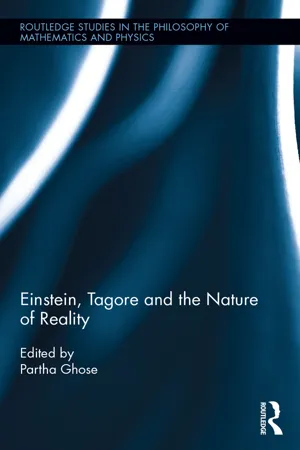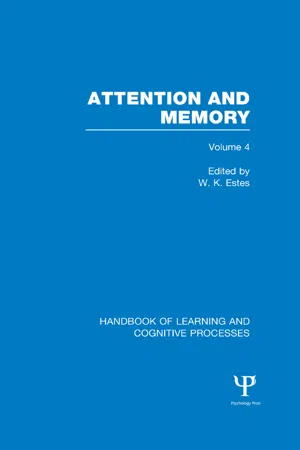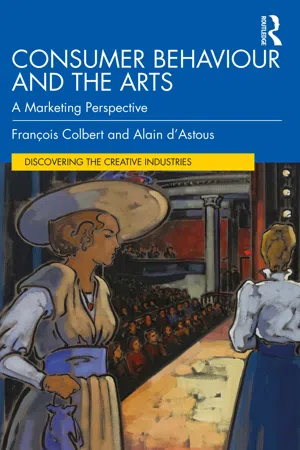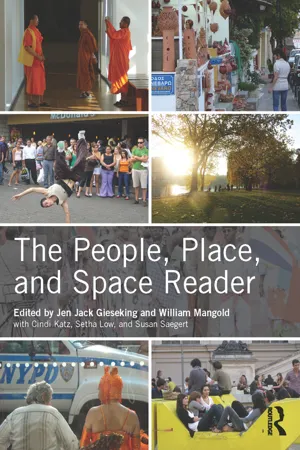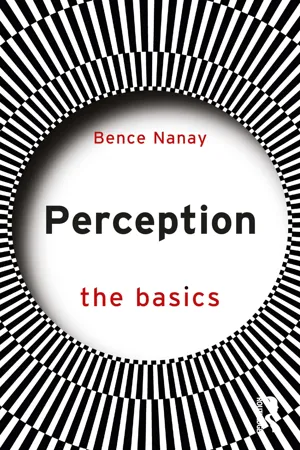Psychology
Perceptual Set
Perceptual set refers to a person's predisposition to perceive stimuli in a certain way based on their expectations, experiences, and motivations. It influences how individuals interpret and organize sensory information, leading to selective attention and the tendency to perceive things in line with their existing beliefs and attitudes. This concept highlights the role of psychological factors in shaping perception.
Written by Perlego with AI-assistance
Related key terms
6 Key excerpts on "Perceptual Set"
- eBook - ePub
- Partha Ghose(Author)
- 2016(Publication Date)
- Routledge(Publisher)
The preceding results showed the involvement of a fronto-parietal network for goal-directed attention, whether to spatial or feature-based demands. In this case, the attentional modulation being studied was that of a top-down nature—the subject was made aware of an impending requirement for attentional allocation. This raises the question as to what networks are involved in stimulus-driven, bottom-up attentional recruitment—such as after the sudden appearance of a stimulus. It turns out that in this case, a somewhat different set of brain areas are involved—a more ventral set of structures in the frontal and parietal lobes of the right hemisphere as opposed to the dorsal bilateral set involved in goal-directed attention. This network is involved in directing our attention in an automated manner to a sensory stimulus that has either appeared suddenly or to which we need to suddenly allocate our attentional resources for greater scrutiny.Perceptual Set
As discussed above, attention—or the lack of it—can modulate the perceptual experience to the point where we may not even see something so obvious as a person in a gorilla suit entering our visual field. Similarly, the nature and content of our prior experiences with a stimulus, which is retained in our memory systems, can produce compelling effects on how we perceive that stimulus. The phenomena that have been discussed thus far have led a group of psychologists and cognitive scientists to make a forceful case for a constructivist theory of perception, which stresses the role of knowledge and other cognitive operations in perception.We now complete our discussion of this issue by reviewing a set of causes that together affect the Perceptual Set —a tendency to experience stimuli based on a set of cognitive factors. There are four general factors that together influence the Perceptual Set: expectation, motivation, emotion and culture. The role of expectation - eBook - ePub
Handbook of Learning and Cognitive Processes (Volume 4)
Attention and Memory
- William Estes(Author)
- 2014(Publication Date)
- Psychology Press(Publisher)
5
David LaBerge University of MinnesotaPerceptual Learning and AttentionLong before psychology became a recognized discipline, scholars debated the question of how we learn to perceive the physical world around us. Philosophers have traditionally considered this issue as central to the domain of epistemology in which the important positions were established by Descartes, who assumed knowledge to be innate, by Locke, who claimed that all knowledge comes through the senses, and by Kant, who assumed a kind of middle ground in which information coming through the senses is always structured by categories which themselves are innate. These viewpoints have carried over into psychology, where they have had a profound, but often unnoticed, effect upon the kinds of questions asked, the types of evidence accepted, and the sorts of theoretical accounts generated. From the beginnings of experimental psychology with Wundt and James to the work of the Gestaltists and more current research of Hebb (1949), Piaget (1971), and the Gibsons (E. J. Gibson, 1969; J. J. Gibson, 1966; Gibson & Gibson, 1955), specialists in perception have generally been more aware of their epistemological underpinnings than psychologists in general.Currently the problem of perception of the physical world is being studied by an increasing number of investigators within the framework of information-processing theory. Perception is considered to be one of the earliest stages of processing that takes place on the stimulus input before the information reaches higher cognitive levels where decisions, comprehension, storage, rehearsal, and retrieval operations are performed. The big questions are the old ones rephrased: To what extent is the perceptual processing mechanism innate? What is built up from experience? What is the nature and extent of the modifications made by the perceptual processor on the input from the physical world? - eBook - ePub
Consumer Behaviour and the Arts
A Marketing Perspective
- François Colbert, Alain d'Astous(Authors)
- 2021(Publication Date)
- Routledge(Publisher)
PART 3EXPERIENCE
Passage contains an image
Chapter 3
Perception
DOI: 10.4324/9780429263118-6In marketing and social sciences, it is common to view perception as a process one can define with a set of steps and a clear linear sequence (e.g., Solomon, 2017 ). This view holds that a variety of stimuli (images, sounds, odours, etc.) reach the senses of the consumer (sight, hearing, taste, smell, and touch) before being selected, organized, and then interpreted by the brain. This sequence constitutes what is called the perceptual experience.Although, as we shall see further on, this view of perception is not consistent with many results from psychology research—notably, that perception is usually immediate and deep—it is useful for how it distinguishes three fundamental themes one must integrate into any discussion of perceptual experience: selective perception, perceptual organization, and interpretation. We will address each of these themes in turn.Selective perception
Consumers are exposed to a considerable number of stimuli of all kinds. It is logically impossible for them to take everything into account, so they must be selective. The process of selecting information in the environment is either voluntary (e.g., a given person may choose to mute the ad appearing on her smartphone before the broadcast of a news report) or involuntary (e.g., when we hear a fire alarm being triggered). Beyond these two obvious conditions of selective perception, there also exists a process of automatic selection, that is, selection based on a person’s objectives, motivations, or psychic state. For example, a consumer who likes a particular brand will tend to perceive (and no doubt also remember) more positive information in that brand’s advertising than will a different person who is resistant to it. From this perspective, it becomes clear that perception is a fundamentally individual process. - eBook - ePub
- Jen Jack Gieseking, William Mangold, Cindi Katz, Setha Low, Susan Saegert, Jen Jack Gieseking, William Mangold, Cindi Katz, Setha Low, Susan Saegert(Authors)
- 2014(Publication Date)
- Routledge(Publisher)
2 Human Perception and Environmental ExperiencePsychological map of Paris.Referenced in: Milgram, Stanley and Denise Jodelet. 1970. “Psychological Maps of Paris” in H.M. Proshansky, et al., eds., Environmental Psychology: People and their Physical Setting. New York: Holt, Rinehart & Winston.Perception describes the multiple ways in which people receive information from their surroundings, allowing them to know their environment. Cognition, or the way people understand the environment, occurs through immediate sensory experience coupled with memories and experiences from the past. While psychologists often treat these as different phenomena or faculties, the papers in this section challenge that bifurcation. Psychological studies of perception and cognition look at how we organize, identify, and interpret information through our senses. Other experiments, including projects by artists and designers, have shed light on how we attach meaning to particular places and spaces. Ecological psychology and other interdisciplinary research has demonstrated that human beings and their environments are produced in relation with one another. In this way, knowledge and experience are situated in the interplay between person and environment. Specific places and moments generate particular knowledge and experiences; previous experiences shade understandings and lead people to recognize particular things or respond in specific ways.Traditionally, the environment was thought of as the context for or container of human activity, and many areas of psychology have proceeded as if what is “out there” in the environment is perceived by humans “in” our brains. However, John Dewey's (1896) landmark critique of the reflex arc denied the separation between external stimulus and internal response by showing the interrelatedness of events, environments, people, and actions. By the mid-20th century, psychologist Kurt Lewin's (1997 [1943] ) concept of the lifespace described how elements of the environment make up a sort of force field within which people live their lives. Lewin felt that the social and physical environment or field - eBook - ePub
Cross-Cultural Psychology
Critical Thinking and Contemporary Applications, Sixth Edition
- Eric B. Shiraev, David A. Levy(Authors)
- 2016(Publication Date)
- Routledge(Publisher)
Sensation and perception are two basic processes first studied in psychological laboratories more than 100 years ago in several countries, including Germany, France, Russia, Great Britain, and the United States. Comparative analysis of the data obtained by these laboratories shows remarkable quantitative and qualitative similarities—despite individual differences—in both sensory and perceptual processes in people of different countries (Yaroshevski, 1996). However, in most experiments, psychologists studied sensation using a “standard” (for psychological research in the 1800s) sample of subjects: the researchers themselves, their academic assistants, and, of course, the students. Therefore, the data in such studies were obtained mainly from highly educated, white male subjects. Cross-cultural investigation of sensation is surmised to have begun with the research conducted by Rivers (1901) and associates, who selected their subjects in Europe and Torres Strait Islands, a territory near Australia. Rivers examined a popular assumption about the extraordinary visual sharpness of non-Europeans. The assumption was disproved: The vision of the Torres Strait Islanders was not found to be outstanding. Nevertheless, cross-cultural studies of sensation and perception have proliferated since this study.How Culture Influences What We Perceive
Our experience with the environment and other people shapes our perception by creating perceptual expectations. These expectations, known as a Perceptual Set, make particular interpretations more likely to occur and increase both the speed and efficiency of the perceptual process. Perceptual Sets common in people of a particular culture can be different in other cultural groups.Personal experience influences one’s sensation and perception. If many individuals from a particular group share such experiences, there should be some common group-related sensory or perceptual patterns. For example, we are usually aware of the aroma outside a restaurant when we are hungry, yet we are much less sensitive to it when our stomach is full. In general, if we need something, we pay attention to the stimuli that are linked to the gratification of the need. But what if a person is constantly deprived of food or water, like millions of people on earth? Years back, researchers examined the effects of food and water deprivation on word identification (Wispe & Drambarean, 1953). The deprived participants perceived the need-related words (words standing for food and drinks) at shorter exposure times than the nondeprived subjects. In another study, researchers compared the perceptual experiences of children from poor and wealthy families (Bruner & Goodman, 1947). They asked children to adjust the size of a circle of light to match the sizes of various coins: a penny, a nickel, a dime, and a quarter. Children from wealthier families tended to see the coins as smaller than they actually were, whereas children from poor families overestimated the size of the coins. The investigators argued that the need for money among children from poor homes influenced their perception of the coins. This interesting finding has been reproduced in Hong Kong with similar results (Dawson, 1975). - eBook - ePub
- Bence Nanay(Author)
- 2024(Publication Date)
- Routledge(Publisher)
Where does this leave us with regard to the circularity worry, that is, the unbiased nature of perception? If cognitive processes influence perception, then perception can’t be taken to be an unbiased guide to how the world is. We always see the world through the veil of the prejudices our beliefs and other cognitive processes provide.Is this really a worry? Remember what the perceptual system is supposed to do. It has the incredibly difficult task of putting together a representation of the features of the world around us on the basis of very sparse input that we receive through the senses. If the perceptual system is to come up with the most likely model of the world around us, it is better off using all kinds of information that it has about the likely layouts and the most probable arrangements of features. And this very much includes information that is stored outside the perceptual system.In other words, the fact that perception is not unbiased is not necessarily a bad thing. Paradoxically, if it is biased, it could give us a more accurate representation of the world around us. And the best demonstration of this is perceptual learning (I want to leave open the question about whether perceptual learning counts as top-down influence – the point is that the bias it introduces is not a negative influence).As we have seen in Section 1.4 , perceptual learning is the psychological phenomenon that perceiving a certain kind of stimulus leaves a mark on the perceptual system, so the next time you perceive a similar kind of stimulus, your perception of it will be different. Because of perceptual learning, our perception depends on past perceptual episodes – on what kind of perceptual stimuli we’ve encountered before. Our imprinted perceptual history (dictated by what we have encountered throughout our lives and especially in our early formative years) has an impact on how we perceive the world now.Perception is not a fixed mechanism. It changes over our lifetime. What you perceive now influences how you perceive the world later. In some cases, this influence can be quite radical. Consider the example of perceptual discrimination (see Stokes and Nanay 2020 ). Fingerprint experts can differentiate two very similar fingerprints quickly and reliably – in a way novices cannot. Before undergoing extensive forensic fingerprint training, the expert looked at the very same stimulus she does now, but her perceptual processes and her perceptual experience are very different. We know from a number of empirical studies that this change entails a change in the way her perceptual system works (see Busey and Parada 2010 , Jarodzka et al. 2010
Index pages curate the most relevant extracts from our library of academic textbooks. They’ve been created using an in-house natural language model (NLM), each adding context and meaning to key research topics.
